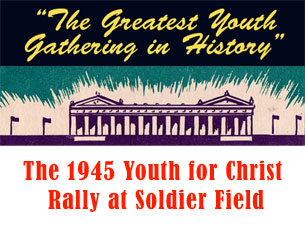On the evening of Memorial Day, 1945, 70,000 people gathered at the Soldier Field stadium in Chicago to witness an open-air pageant. Like other ceremonies on that day, this one remembered fallen servicemen and rededicated a nation still at war to a global mission. This rally had another major purpose, however. It celebrated the first anniversary of the Chicago-area chapter of “Youth for Christ,” a rapidly growing evangelistic youth movement. By mid-1945, its leaders estimated that their Youth for Christ rallies thrived in three hundred to four hundred cities and towns, with nearly half a million attending, while soldiers and sailors held dozens of similar rallies in Europe and the Pacific.
The Soldier Field rally reflected, in one spectacular event, the convergence of a renewed, exuberant evangelicalism and the war-inspired revival of the American civic faith. Its musical program praised God and country with a three-hundred-piece band, a choir of five thousand, and several well- known gospel singers, including George Beverly Shea. On the field, the religious and patriotic program began with a flag ceremony performed by high school cadets and four hundred marching nurses. Next followed a pageant featuring missionary volunteers in national costumes dramatizing the call to evangelize the world. Standing for America was a young evangelist named Billy Graham; he issued a summons for another great revival. On the platform, war heroes attested to their faith, as did intercollegiate boxing titlist Bob Finley. Track star Gil Dodds, the record-holder for the indoor mile, ran an exhibition lap before giving his testimony. The evening’s preacher followed; he was Percy Crawford, director of the nationally broadcast “Young People’s Church of the Air” At his gospel invitation, hundreds signed “decision cards.” As the meeting drew to a close, a spotlight circled the darkened stadium, while a huge neon sign blazed “Jesus Saves” and the choir sang “We Shall Shine as Stars in the Morning.”
Indeed they did, for this extravaganza attracted major news coverage. The Chicago papers, the wire services, and Newsweek magazine carried stories of the rally, and, a few weeks later, William Randolph Hearst editorially blessed the youth movement and ordered his twenty-two newspapers to feature the rallies. Not since the Scopes trial had evangelical Christianity received such coverage, and, this time, most of it was friendly.
Youth for Christ was one of the most striking early signs of a rising new evangelical movement, which has remained a prominent factor in American life since then. By the late 1940s, rallies had grown to over one thousand in number, with an estimated weekly attendance of one million people: Youth for Christ evangelists had preached by then in forty-six countries. Too restless and visionary to settle down to the task of ministering to teenagers, many of the movement’s early leaders, notably Billy Graham and Bob Pierce, founder of World Vision, infused a larger postwar evangelical coalition with their energy. These youthful evangelists created a variety of new organizations and communicated their message with popular broadcasts and publications. They merged their desire to be helpful contributors to the “American cause” with a renewed vision for world evangelization and revival in the United States. Youth for Christ thus became the spearhead of a postwar evangelistic thrust and the first dramatic sign that American evangelicals were “coming in from the cold.”
The Youth for Christ sensation of 1944-47 has become a bit of trivia in American historical narrative, but it is worth recovering and examining. Historians are beginning to pay more attention to the World War II experience as a powerful shaper of contemporary America. Likewise, they have devoted more interest recently to evangelical Christianity’s role in American culture. |



